
National
Skydiving
League
226 Pecan Street
Deland FL 32724
tel: (386) 801-0804
© 2003 - 2025
All Rights Reserved


226 Pecan Street
Deland FL 32724
tel: (386) 801-0804
© 2003 - 2025
All Rights Reserved

The new videos offer the next opportunity for the audience to look for infringements. Perris Fury lost a total of four points in the first round of the meet. The damage in Round 2 was only a 1-point deduction.
The details of Evolution's penalties are not available. However, the two new videos show that the Canadian team was still collecting point deductions due to video issues with and right after the exit.

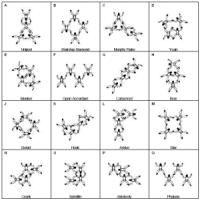
Building randoms involves the same disciplines as creeping. The most important part is: STOP! Every formation should be stopped when grips are taken. The steps in building a Random Formation are:
1. Cross-reference and move to your slot
2. STOP
3. Take grips
4. Make eye contact and key
Cross-referencing is also extremely important. This is crucial to knowing where to go, and is the key to maintaining equal fall rates. As in creeping, it is essential to:
- Place your grips in comfortable reach for your teammates.
- Move to the correct place to take comfortable grips rather than reaching for them.

- The Team Fastrax website
- The USPA Competition Manual
- The NSL website

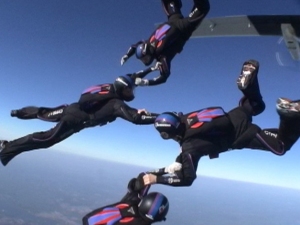
The keys to a successful exit are presentation and timing. As any skydiver knows, if one or more jumpers are not presented properly, belly to relative wind, a funnel is just about guaranteed. Except in some of the more difficult formations, presentation is easy. The hard part is timing.
To exit together, a team must have a good exit count to which everyone is accustomed. Either the Inside Center or the Outside Center may perform this count. It may be desirable to have the Inside Center do the count for some formations and have the Outside Center do others. Each team will work out the system that works best for them.
In order to save time, a formation can be launched with all grips intact. By exiting intact, a team can save time by eliminating the need to build or transition to the first point. However, this advantage is quickly erased if the launch is less than successful.
With 38 different exits in the AAA/Open Class dive pool, a certain amount of experience and training is required to exit every formation consistently and confidently. A junior team may be better off choosing to only exit a few different formations and transitioning as needed. Some basic launches are Meeker (E), Stairstep Diamond (B), Satellite (O), and Sidebody (P).

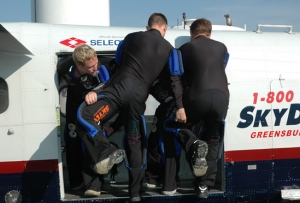
Point: Diving from the front of the door, the Point flyer has a grip of the Outside Center's left leg with his left hand. The Point flyer will lift his right side up for the proper presentation while getting his centerpoint up toward the wing.
Outside Center: Holding the bar with the left arm, the Outside Center flyer will have the left leg of the Tail flyer with his right arm. On exit this flyer will get his legs and hips up toward the wing, while his upper body rotates down.
Inside Center: Diving from the center of the door, the Iside Cnter flyer will have a grip of the Outside Center with the left hand and the left leg of the point with his right hand. This flyer will make a small hop to barely clear the door and drop his left hip down as he quickly expands into an arch.
Tail: Taking the rear float position, the Tail flyer will have the Inside Center's left leg with his left hand. On exit this flyer will aggressively drop his right side down.
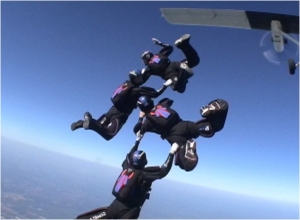
Timing Everybody needs to leave the airplane at the same time. The team needs to leave as one unit instead of four separate bodies. A key element here is to have a solid exit count. The count should be done by either the inside or outside center. It is important that the count be consistent and visible to everybody. Practice on the ground can create good exit timing.
Placement The door forces a team tighter together than they will be in freefall. As the formation leaves the door, it must expand so that everybody has his or her own air to fly. Each individual needs to know where to go and go there. This is a purely gymnastic skill and not a flying skill.
Each member of the team should know his or her target, relative to his or her teammates, when leaving the door. For instance, when exiting a Meeker, the Tail wants to end up below the rest of the team, the Point wants to leap above them, the Outside Center wants to launch out toward the wingtip and be slightly above the Inside Center, and the Inside Center wants to shoot his or her hips down through the corner of the door and end up below the Outside Center.
Presentation Each individual must present properly to the relative wind. From a Twin Otter, this requires the divers to lift their right side as they lower their left side. The opposite is true for the floaters. Once you have exited you must see any small errors and correct them. Your eyes must be up and looking through the center. See the levels and be aware.
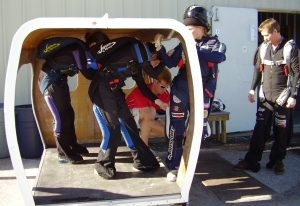
- What everybody's stance in the door is.
- Which grips are taken in the door, and which are dropped or picked up after exit.
- Who gives the count, and how.